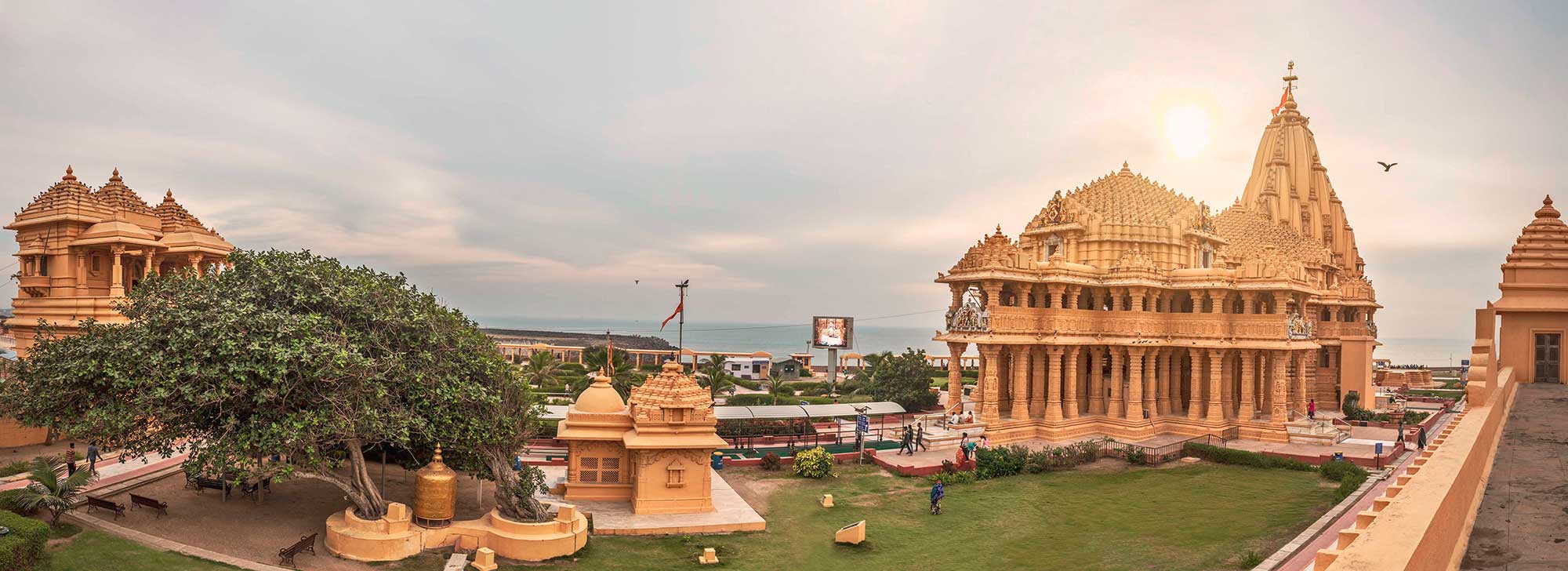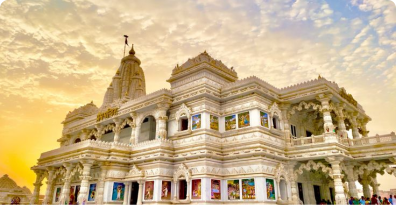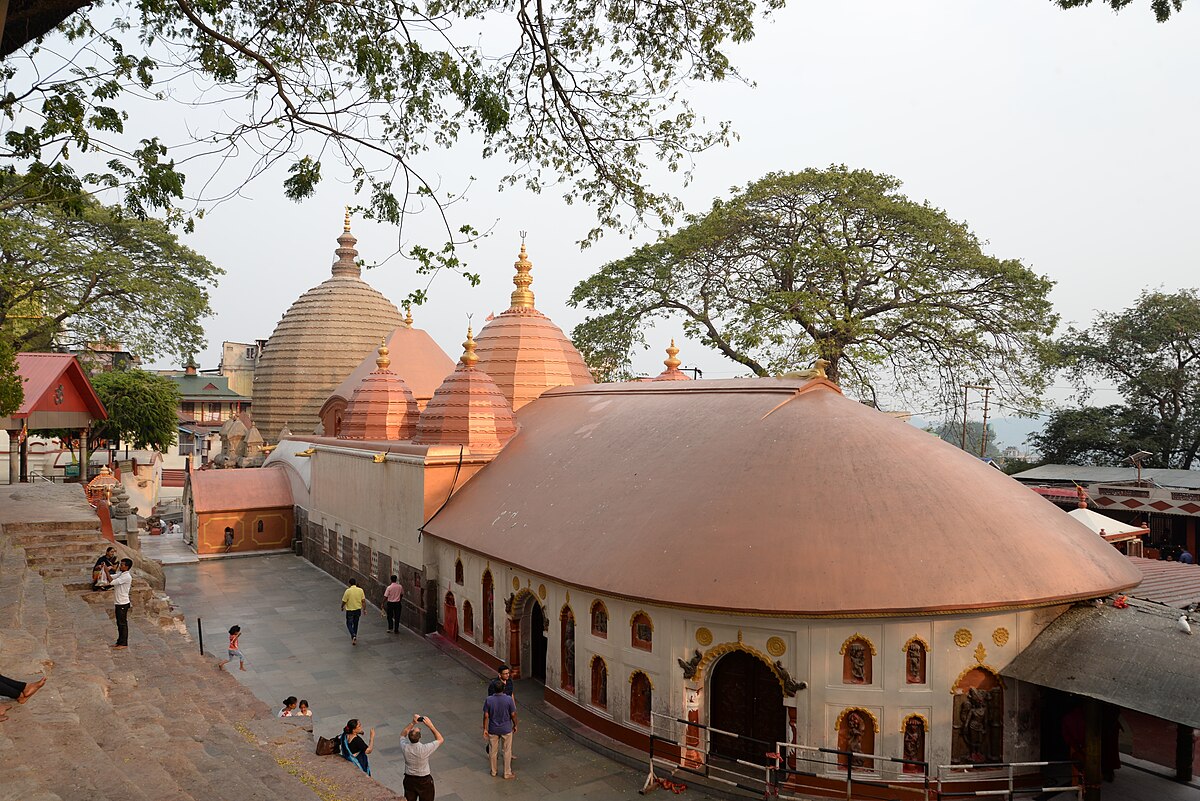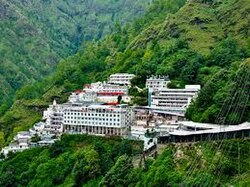
October 06, 2025
Temple Mandir
6 min read
Somnath Temple
Perched on the western coast of Gujarat, overlooking the Arabian Sea, the Somnath Temple is a symbol of resilience, faith, and spiritual grandeur. Dedicated to Lord Shiva, this temple is revered as the first among the twelve Jyotirlingas and has withstood the test of time, facing repeated invasions yet rising again in all its glory. Legends say that worshipping at Somnath can cleanse one’s soul and bring divine blessings. The temple’s stunning architecture, serene surroundings, and the rhythmic chants of devotion create an aura of peace and spiritual energy. Beyond its religious significance, Somnath Temple stands as a testament to India’s enduring cultural heritage, devotion, and unwavering faith through the centuries.
Somnath Temple, Gujarat: The Eternal Jyotirlinga of Lord Shiva
Introduction
The Somnath Temple, located on the coast of Prabhas Patan near Veraval in Gujarat, is one of the most revered Shiva temples in India. Dedicated to Lord Shiva in the form of a Jyotirlinga, it is known as the “first among the twelve Jyotirlingas”, making it a focal point of Shaivite devotion.
Somnath, meaning “Lord of the Moon”, has been a symbol of faith, resilience, and devotion for centuries. The temple’s spiritual significance, tumultuous history, and magnificent architecture make it a must-visit destination for pilgrims and history enthusiasts alike. Devotees believe that visiting Somnath removes sins, grants spiritual merit, and ensures liberation (Moksha).
Nestled against the backdrop of the Arabian Sea, the temple’s golden spire glistens in the sunlight, creating a serene and powerful aura that attracts millions of devotees annually.
Historical Background
The history of Somnath Temple is a chronicle of devotion, destruction, and restoration. Ancient texts like the Skanda Purana and Shiva Purana mention Somnath as the site where Lord Shiva manifested as a Jyotirlinga. The temple has been destroyed and rebuilt multiple times by various invaders, including Mahmud of Ghazni in the 11th century, yet it has always risen again, symbolizing the resilience of faith.
The present structure was reconstructed in 1951 under the initiative of Sardar Vallabhbhai Patel, the first Deputy Prime Minister of India, blending Chalukya and Gujarati temple architectural styles. The temple complex is spread over acres, with intricately carved pillars, majestic domes, and spacious courtyards that reflect the grandeur of ancient Indian craftsmanship.
Archaeological evidence and inscriptions suggest that Somnath has been a prominent pilgrimage center for over 2,000 years, attracting saints, kings, and scholars alike. Its strategic location on the western coast also made it a hub for trade, culture, and spiritual discourse.
Myths & Stories
Somnath Temple is steeped in mythology and divine stories. One of the most famous legends involves the Moon God, Chandra, who, cursed by his father Daksha, sought Lord Shiva’s grace. Shiva appeared at Somnath in the form of a Jyotirlinga, lifting Chandra’s curse. This story gives the temple its name, Somnath (Lord of the Moon).
Another tale speaks of Lord Shiva manifesting as a fiery column of light, which could not be contained by any ruler or sage. This eternal Jyotirlinga symbolizes Shiva’s infinite energy and divine presence.
Local legends also narrate that Aditya, the Sun God, and other celestial beings visited Somnath to witness Shiva’s glory, adding to the temple’s mystical allure. The stories of repeated destruction and miraculous survival further reinforce its spiritual significance, making it a symbol of enduring faith.
Devotees recount personal experiences of divine intervention and blessings at Somnath, emphasizing the temple’s aura of sanctity and miraculous power.
Festivals & Rituals
The Somnath Temple is alive with vibrant festivals and ancient rituals. The most important festival is Maha Shivratri, celebrated with grandeur and devotion. Thousands of devotees gather to chant Om Namah Shivaya, offer milk and flowers to the Jyotirlinga, and participate in night-long vigils.
Other significant festivals include Shravan Maas, Kartik Purnima, and Pradosh Vrat, during which special rituals and ceremonies are performed. The temple priests conduct Abhishekam (ritual bathing of the Jyotirlinga), Archana (prayers), and Rudrabhishek, creating an immersive spiritual experience.
A unique feature of Somnath Temple is its seaside Aarti, performed at sunrise and sunset, where the waves of the Arabian Sea meet the divine chants. This ritual not only symbolizes the union of nature and divinity but also provides devotees with a serene and uplifting experience.
The temple also follows strict daily rituals, starting with Mangala Aarti at dawn, followed by Bhog offerings, Maha Aarti, and Sandhya Aarti in the evening, maintaining a continuous rhythm of devotion and worship.
Visitor Experience
Visiting Somnath Temple is a mesmerizing spiritual and cultural journey. The temple is located on the western coast, surrounded by scenic beaches, historical monuments, and bustling local markets. Pilgrims often visit early in the morning to witness the sunrise over the Arabian Sea, creating a serene and divine ambiance.
The temple complex is well-organized, offering facilities for accommodation, guided tours, and smooth darshan arrangements. Security and crowd management are prioritized, especially during festivals, ensuring a safe experience for all.
Nearby attractions include Bhalka Tirth, Triveni Sangam, and Gir National Park, adding historical, spiritual, and ecological dimensions to the visit. Exploring these sites provides a holistic understanding of the region’s cultural and natural heritage.
The temple also offers prasadams, local delicacies, and souvenirs that allow visitors to take a piece of divine blessing home. Photography is restricted inside the sanctum but allowed in the outer courtyards, enabling pilgrims to capture the temple’s grandeur.
Spiritual Significance
Somnath Temple holds immense spiritual significance as the first Jyotirlinga among the twelve sacred Shiva shrines in India. Devotees believe that offering prayers here removes sins, fulfills desires, and grants Moksha.
The temple’s location by the sea symbolizes the eternal flow of life and divine energy, while the Jyotirlinga itself represents Lord Shiva’s infinite light and presence. Worshipping at Somnath is believed to enhance spiritual awareness, inner peace, and devotion.
The temple also embodies the resilience of faith, having survived repeated destruction and yet continuing to radiate divine energy. It stands as a beacon of hope, devotion, and eternal spiritual power, inspiring generations of devotees.
Conclusion
The Somnath Temple of Gujarat is not merely a religious site; it is a symbol of faith, resilience, and divine grace. From its mythical origins and celestial stories to its grand architecture and serene seaside rituals, Somnath continues to inspire devotion and awe.
A visit to Somnath is a spiritual journey, where one experiences the divine light of Lord Shiva, the mystical aura of the Jyotirlinga, and the timeless power of faith. Whether you are a devotee seeking blessings, a traveler exploring history, or a spiritual seeker, Somnath Temple offers a transformative experience that touches the heart and soul.
The golden spire, the rhythmic chants, the endless waves, and the stories of devotion and survival make Somnath a timeless symbol of India’s spiritual heritage, reminding humanity of the enduring presence of the divine.
Introduction
The Somnath Temple, located on the coast of Prabhas Patan near Veraval in Gujarat, is one of the most revered Shiva temples in India. Dedicated to Lord Shiva in the form of a Jyotirlinga, it is known as the “first among the twelve Jyotirlingas”, making it a focal point of Shaivite devotion.
Somnath, meaning “Lord of the Moon”, has been a symbol of faith, resilience, and devotion for centuries. The temple’s spiritual significance, tumultuous history, and magnificent architecture make it a must-visit destination for pilgrims and history enthusiasts alike. Devotees believe that visiting Somnath removes sins, grants spiritual merit, and ensures liberation (Moksha).
Nestled against the backdrop of the Arabian Sea, the temple’s golden spire glistens in the sunlight, creating a serene and powerful aura that attracts millions of devotees annually.
Historical Background
The history of Somnath Temple is a chronicle of devotion, destruction, and restoration. Ancient texts like the Skanda Purana and Shiva Purana mention Somnath as the site where Lord Shiva manifested as a Jyotirlinga. The temple has been destroyed and rebuilt multiple times by various invaders, including Mahmud of Ghazni in the 11th century, yet it has always risen again, symbolizing the resilience of faith.
The present structure was reconstructed in 1951 under the initiative of Sardar Vallabhbhai Patel, the first Deputy Prime Minister of India, blending Chalukya and Gujarati temple architectural styles. The temple complex is spread over acres, with intricately carved pillars, majestic domes, and spacious courtyards that reflect the grandeur of ancient Indian craftsmanship.
Archaeological evidence and inscriptions suggest that Somnath has been a prominent pilgrimage center for over 2,000 years, attracting saints, kings, and scholars alike. Its strategic location on the western coast also made it a hub for trade, culture, and spiritual discourse.
Myths & Stories
Somnath Temple is steeped in mythology and divine stories. One of the most famous legends involves the Moon God, Chandra, who, cursed by his father Daksha, sought Lord Shiva’s grace. Shiva appeared at Somnath in the form of a Jyotirlinga, lifting Chandra’s curse. This story gives the temple its name, Somnath (Lord of the Moon).
Another tale speaks of Lord Shiva manifesting as a fiery column of light, which could not be contained by any ruler or sage. This eternal Jyotirlinga symbolizes Shiva’s infinite energy and divine presence.
Local legends also narrate that Aditya, the Sun God, and other celestial beings visited Somnath to witness Shiva’s glory, adding to the temple’s mystical allure. The stories of repeated destruction and miraculous survival further reinforce its spiritual significance, making it a symbol of enduring faith.
Devotees recount personal experiences of divine intervention and blessings at Somnath, emphasizing the temple’s aura of sanctity and miraculous power.
Festivals & Rituals
The Somnath Temple is alive with vibrant festivals and ancient rituals. The most important festival is Maha Shivratri, celebrated with grandeur and devotion. Thousands of devotees gather to chant Om Namah Shivaya, offer milk and flowers to the Jyotirlinga, and participate in night-long vigils.
Other significant festivals include Shravan Maas, Kartik Purnima, and Pradosh Vrat, during which special rituals and ceremonies are performed. The temple priests conduct Abhishekam (ritual bathing of the Jyotirlinga), Archana (prayers), and Rudrabhishek, creating an immersive spiritual experience.
A unique feature of Somnath Temple is its seaside Aarti, performed at sunrise and sunset, where the waves of the Arabian Sea meet the divine chants. This ritual not only symbolizes the union of nature and divinity but also provides devotees with a serene and uplifting experience.
The temple also follows strict daily rituals, starting with Mangala Aarti at dawn, followed by Bhog offerings, Maha Aarti, and Sandhya Aarti in the evening, maintaining a continuous rhythm of devotion and worship.
Visitor Experience
Visiting Somnath Temple is a mesmerizing spiritual and cultural journey. The temple is located on the western coast, surrounded by scenic beaches, historical monuments, and bustling local markets. Pilgrims often visit early in the morning to witness the sunrise over the Arabian Sea, creating a serene and divine ambiance.
The temple complex is well-organized, offering facilities for accommodation, guided tours, and smooth darshan arrangements. Security and crowd management are prioritized, especially during festivals, ensuring a safe experience for all.
Nearby attractions include Bhalka Tirth, Triveni Sangam, and Gir National Park, adding historical, spiritual, and ecological dimensions to the visit. Exploring these sites provides a holistic understanding of the region’s cultural and natural heritage.
The temple also offers prasadams, local delicacies, and souvenirs that allow visitors to take a piece of divine blessing home. Photography is restricted inside the sanctum but allowed in the outer courtyards, enabling pilgrims to capture the temple’s grandeur.
Spiritual Significance
Somnath Temple holds immense spiritual significance as the first Jyotirlinga among the twelve sacred Shiva shrines in India. Devotees believe that offering prayers here removes sins, fulfills desires, and grants Moksha.
The temple’s location by the sea symbolizes the eternal flow of life and divine energy, while the Jyotirlinga itself represents Lord Shiva’s infinite light and presence. Worshipping at Somnath is believed to enhance spiritual awareness, inner peace, and devotion.
The temple also embodies the resilience of faith, having survived repeated destruction and yet continuing to radiate divine energy. It stands as a beacon of hope, devotion, and eternal spiritual power, inspiring generations of devotees.
Conclusion
The Somnath Temple of Gujarat is not merely a religious site; it is a symbol of faith, resilience, and divine grace. From its mythical origins and celestial stories to its grand architecture and serene seaside rituals, Somnath continues to inspire devotion and awe.
A visit to Somnath is a spiritual journey, where one experiences the divine light of Lord Shiva, the mystical aura of the Jyotirlinga, and the timeless power of faith. Whether you are a devotee seeking blessings, a traveler exploring history, or a spiritual seeker, Somnath Temple offers a transformative experience that touches the heart and soul.
The golden spire, the rhythmic chants, the endless waves, and the stories of devotion and survival make Somnath a timeless symbol of India’s spiritual heritage, reminding humanity of the enduring presence of the divine.


